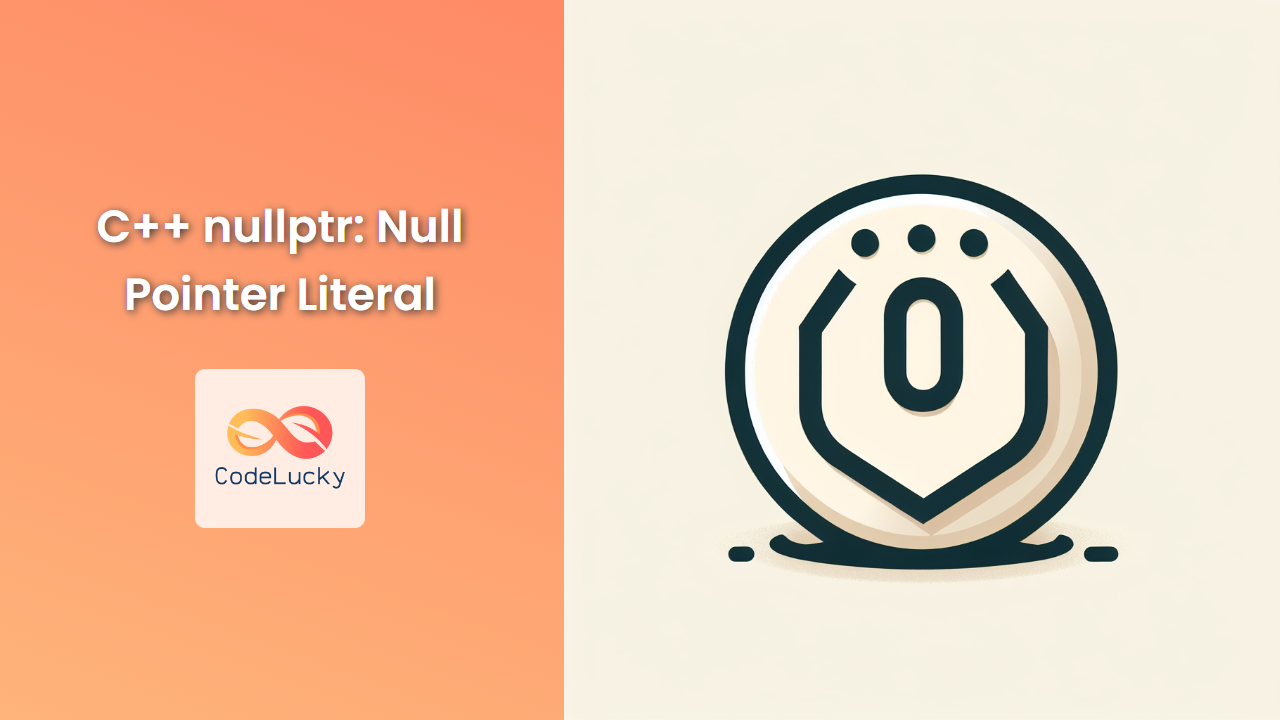In the realm of C++ programming, handling pointers effectively is crucial for writing robust and efficient code. One of the most important concepts in pointer management is the null pointer, which represents a pointer that doesn't point to any valid memory location. In this comprehensive guide, we'll dive deep into the nullptr keyword, a null pointer literal introduced in C++11, and explore its significance, usage, and best practices.
Understanding nullptr
nullptr is a keyword in C++ that represents a null pointer literal. It's a constant of type std::nullptr_t, which is implicitly convertible and comparable to any pointer type. The introduction of nullptr in C++11 addressed several issues and ambiguities associated with the use of NULL and 0 as null pointer values in earlier versions of C++.
🔑 Key benefits of nullptr:
- Type-safe: Unlike
NULL,nullptrcan't be implicitly converted to integral types. - Improved overload resolution: Helps avoid ambiguity in function overloading.
- Enhanced code readability: Clearly expresses the intent of a null pointer.
Let's explore these benefits with practical examples.
nullptr vs. NULL and 0
To understand the advantages of nullptr, let's first look at the problems with using NULL and 0 as null pointer values.
#include <iostream>
void foo(int i) {
std::cout << "foo(int) called with " << i << std::endl;
}
void foo(char* p) {
std::cout << "foo(char*) called" << std::endl;
}
int main() {
foo(0); // Calls foo(int)
foo(NULL); // May call foo(int) or foo(char*) depending on the implementation
foo(nullptr); // Always calls foo(char*)
return 0;
}
In this example, foo(0) unambiguously calls the int overload. However, foo(NULL) can be ambiguous because NULL might be defined as 0 or as (void*)0, depending on the implementation. foo(nullptr), on the other hand, always calls the pointer overload, providing consistency across different compilers and platforms.
Type Safety with nullptr
nullptr provides improved type safety compared to NULL or 0. Let's see how:
#include <iostream>
int main() {
int* p1 = nullptr; // OK
int* p2 = 0; // OK, but less clear
int* p3 = NULL; // OK, but potentially ambiguous
int i1 = nullptr; // Error: cannot convert nullptr to int
int i2 = 0; // OK
int i3 = NULL; // May compile, but potentially dangerous
if (p1 == nullptr) std::cout << "p1 is null" << std::endl;
if (p2 == 0) std::cout << "p2 is null" << std::endl;
if (p3 == NULL) std::cout << "p3 is null" << std::endl;
return 0;
}
In this example, nullptr can't be implicitly converted to an integer type, preventing potential errors. This type safety is particularly valuable in template metaprogramming and when working with auto type deduction.
nullptr in Function Overloading
nullptr shines when it comes to function overloading. Let's look at a more complex example:
#include <iostream>
#include <typeinfo>
void process(int* ptr) {
std::cout << "Processing integer pointer" << std::endl;
}
void process(double* ptr) {
std::cout << "Processing double pointer" << std::endl;
}
void process(std::nullptr_t) {
std::cout << "Processing nullptr" << std::endl;
}
template<typename T>
void smartProcess(T* ptr) {
if (ptr == nullptr) {
std::cout << "Smart processing: nullptr for type " << typeid(T).name() << std::endl;
} else {
std::cout << "Smart processing: valid pointer for type " << typeid(T).name() << std::endl;
}
}
int main() {
int* iptr = nullptr;
double* dptr = nullptr;
process(iptr); // Calls process(int*)
process(dptr); // Calls process(double*)
process(nullptr); // Calls process(std::nullptr_t)
smartProcess(iptr);
smartProcess(dptr);
smartProcess(nullptr); // Error: can't deduce T
return 0;
}
This example demonstrates how nullptr allows for more precise function overloading. The process(std::nullptr_t) overload is called specifically when nullptr is passed, providing a way to handle null pointers generically.
nullptr in Templates and Auto Deduction
nullptr plays well with modern C++ features like templates and auto type deduction. Let's explore this with an example:
#include <iostream>
#include <type_traits>
template<typename T>
void checkNull(T ptr) {
if (ptr == nullptr) {
std::cout << "Pointer is null" << std::endl;
} else {
std::cout << "Pointer is not null" << std::endl;
}
}
int main() {
auto p1 = nullptr;
auto p2 = static_cast<int*>(nullptr);
std::cout << "Type of p1: " << typeid(p1).name() << std::endl;
std::cout << "Type of p2: " << typeid(p2).name() << std::endl;
checkNull(p1);
checkNull(p2);
std::cout << "Is p1 nullptr_t? " << std::is_same<decltype(p1), std::nullptr_t>::value << std::endl;
std::cout << "Is p2 nullptr_t? " << std::is_same<decltype(p2), std::nullptr_t>::value << std::endl;
return 0;
}
In this example, auto p1 = nullptr; deduces the type as std::nullptr_t, while auto p2 = static_cast<int*>(nullptr); deduces it as int*. This demonstrates how nullptr interacts with type deduction and can be used in template functions.
Best Practices for Using nullptr
To make the most of nullptr in your C++ code, consider the following best practices:
- 🌟 Always use
nullptrinstead ofNULLor0for null pointers. - 🌟 Use
nullptrin conditions to check for null pointers:if (ptr != nullptr) { /* ... */ } - 🌟 Initialize pointers with
nullptr:int* ptr = nullptr; - 🌟 Use
nullptrin function parameters to indicate optional pointers:void processData(const Data* data = nullptr); - 🌟 Consider overloading functions with
std::nullptr_tfor null-specific behavior.
nullptr in Legacy Code
When working with legacy code or interfacing with C libraries, you might still encounter NULL. Here's how to handle such situations:
#include <iostream>
#include <cstddef>
void legacyFunction(int* ptr) {
if (ptr == NULL) {
std::cout << "Legacy function: ptr is null" << std::endl;
} else {
std::cout << "Legacy function: ptr is not null" << std::endl;
}
}
void modernFunction(int* ptr) {
if (ptr == nullptr) {
std::cout << "Modern function: ptr is null" << std::endl;
} else {
std::cout << "Modern function: ptr is not null" << std::endl;
}
}
int main() {
int* p1 = NULL;
int* p2 = nullptr;
legacyFunction(p1);
legacyFunction(p2);
modernFunction(p1);
modernFunction(p2);
return 0;
}
This example shows that nullptr is compatible with legacy code using NULL. However, it's recommended to use nullptr consistently in new code and when updating existing code.
Performance Considerations
In terms of performance, nullptr is equivalent to using NULL or 0. The benefits of nullptr are in type safety and code clarity, not in runtime performance. Here's a simple benchmark to illustrate this:
#include <iostream>
#include <chrono>
const int ITERATIONS = 1000000000;
void benchmarkNull() {
int* ptr = NULL;
auto start = std::chrono::high_resolution_clock::now();
for (int i = 0; i < ITERATIONS; ++i) {
if (ptr == NULL) { /* do nothing */ }
}
auto end = std::chrono::high_resolution_clock::now();
std::cout << "NULL benchmark: "
<< std::chrono::duration_cast<std::chrono::milliseconds>(end - start).count()
<< " ms" << std::endl;
}
void benchmarkNullptr() {
int* ptr = nullptr;
auto start = std::chrono::high_resolution_clock::now();
for (int i = 0; i < ITERATIONS; ++i) {
if (ptr == nullptr) { /* do nothing */ }
}
auto end = std::chrono::high_resolution_clock::now();
std::cout << "nullptr benchmark: "
<< std::chrono::duration_cast<std::chrono::milliseconds>(end - start).count()
<< " ms" << std::endl;
}
int main() {
benchmarkNull();
benchmarkNullptr();
return 0;
}
Running this benchmark will likely show negligible differences between NULL and nullptr, as the compiler optimizes both cases similarly.
Conclusion
nullptr is a powerful feature in modern C++ that enhances type safety, improves code readability, and resolves ambiguities in pointer handling. By using nullptr consistently in your C++ code, you can write more robust and maintainable software. Remember these key points:
- 🔑
nullptris type-safe and can't be implicitly converted to integral types. - 🔑 It improves function overload resolution, especially with pointer types.
- 🔑
nullptrworks well with modern C++ features like auto type deduction and templates. - 🔑 Using
nullptrdoesn't impact runtime performance compared toNULLor0.
As you continue to develop your C++ skills, make nullptr a standard part of your coding toolkit. It's a small change that can significantly improve the quality and clarity of your code.
















